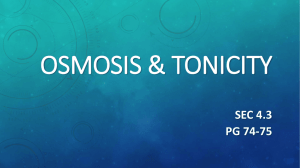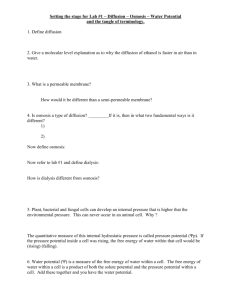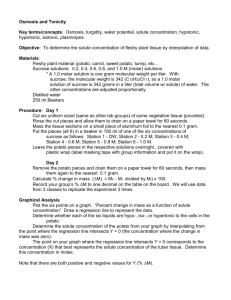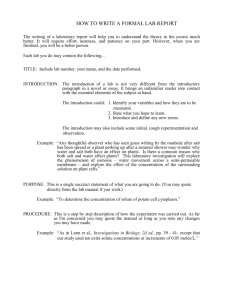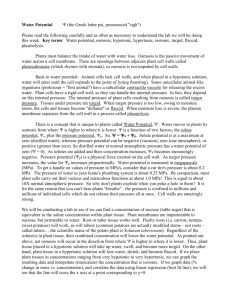OsmosisLab (1)
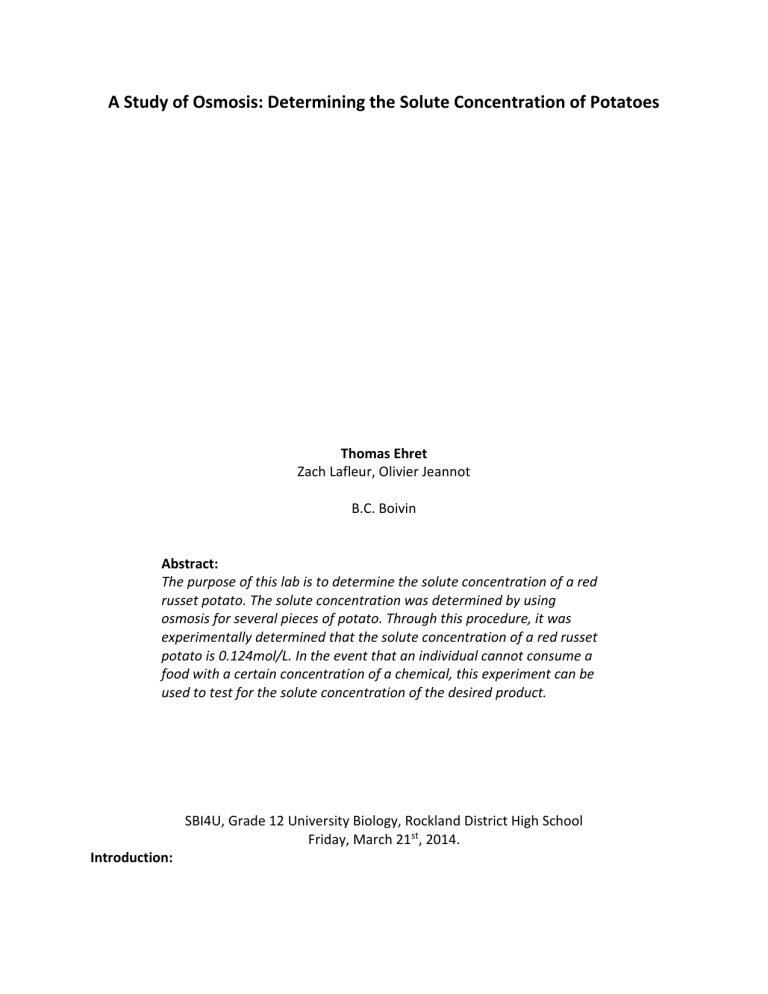
A Study of Osmosis: Determining the Solute Concentration of Potatoes
Thomas Ehret
Zach Lafleur, Olivier Jeannot
B.C. Boivin
Abstract:
The purpose of this lab is to determine the solute concentration of a red russet potato. The solute concentration was determined by using osmosis for several pieces of potato. Through this procedure, it was experimentally determined that the solute concentration of a red russet potato is 0.124mol/L. In the event that an individual cannot consume a food with a certain concentration of a chemical, this experiment can be used to test for the solute concentration of the desired product.
Introduction:
SBI4U, Grade 12 University Biology, Rockland District High School
Friday, March 21 st , 2014.
The goal of this experiment is to determine a value for the solute concentration of a red russet potato.
Solute concentration is a value that describes how much of a solute is dissolved in a solvent. Solute concentration is also called ‘molarity’.
Not only is it important in osmosis, but it is an important variable to consider when measuring the reactants prior to performing a chemical reaction. This is because
Figure 1. Water moving through a semi permeable membrane to dilute the hypertonic solution and reduce the solute concentration (Storesund). using solute concentration, the exact amount of reactants can be calculated so that everything reacts and there is nothing left over from the reactants.
In order to keep a distinction between the environment in the human body and the environment outside of it, cells need to be
selectively permeable or semi permeable. This means that they only allow certain molecules through the membrane (Bushwitz, 2008). Most molecules go through specific proteins in the cell membrane. For example, the proteins that
Figure 2. Particles move through a semi permeable membrane to increase the solute concentration in the hypotonic solution (Anonymous).
water molecules go through to enter and exit a cell are called aquaporins. These proteins make the process of selective permeability much faster and efficient (Bushwitz, 2008).
A general description of osmosis is that it is the movement of water across a semi permeable membrane to lower or raise the solute concentration of the cell or solvent and ultimately to make the cell and the solvent isotonic (Bowen, 2000). In osmosis, water will
always move through the semi permeable membrane to the solution with the higher solute concentration (See Figure 1.). Osmosis is very similar to another process called diffusion which is actually somewhat of an opposite of osmosis. Diffusion is the dispersal of particles from an area of high concentration to an area of low concentration and does not have to be through a semi permeable membrane (See Figure 2.). As seen in ‘Figure 2.’, instead of the water going through the semi permeable membrane to dilute the solution with the higher solute concentration (as it would in osmosis), the particles move to the solution with the lower concentration (Emerson). Both osmosis and diffusion have the intension of making both solutions isotonic, though, diffusion usually occurs within a solution whereas osmosis occurs between a cell and a solution.
The terms isotonic, hypotonic, and hypertonic are used when referring to solutions going through osmosis or diffusion. Isotonic refers to both solutions and means that they have the same solute concentration. Hypotonic refers to the solution with the lower solute concentration while hypertonic refers to the solution with the higher solute concentration. Cells placed in hypertonic solutions will become shriveled because water is being taken from them (See Figure 3.).
Vice versa, cells placed in hypotonic solutions will increase in size because they are absorbing water. The cell wall in a plant cell makes sure that if the cell is put into a hypotonic solution, it will not overfill and break
Figure 3. A demonstration of isotonic, hypotonic, and hypertonic cells (Anonymous, Cell Membrane -
Osmosis).
(Mathison, 2013). An animal cell might go through lysis if it is placed in a hypotonic solution because it does not have the large vacuole that can fill with a lot of water as well as the cell well.
The purpose of this experiment is to accurately measure and calculate the solute concentration of a potato to prove the function of osmosis.
Materials and Methods:
Were those of the A Study of Osmosis: Determining the Solute Concentration of Potatoes lab sheet on Tuesday, March 4 th and Thursday, March 6 th , 2014 (Boivin, 2014).
Results and Observations:
Table 1. Determining the solute concentration in potatoes.
Test Tube #
1
2
3
4
5
6
Solute
Concentration
(mol/L)
0
0.2
0.4
0.6
0.8
1
Initial Mass ‘I’
(g)
See ‘Figure 4.’ to view results graphed.
4.7
4.6
4.8
4.6
4.5
4.7
Final Mass ‘F’ (g) Change in Mass
(F – I) (g)
5.0
4.4
4.4
3.7
3.6
3.4
+0.3
-0.2
-0.4
-0.9
-0.9
-1.3
Calculations:
𝐴𝑐𝑡𝑢𝑎𝑙 (𝑎𝑣𝑒𝑟𝑎𝑔𝑒 𝑜𝑓 3 𝑣𝑎𝑙𝑢𝑒𝑠 𝑓𝑜𝑢𝑛𝑑)(𝑠𝑒𝑒 𝑫𝒊𝒔𝒄𝒖𝒔𝒔𝒊𝒐𝒏) = 0.328𝑚𝑜𝑙/𝐿
%𝑒𝑟𝑟𝑜𝑟 =
𝐴𝑐𝑡𝑢𝑎𝑙 − 𝐸𝑥𝑝𝑒𝑟𝑖𝑚𝑒𝑛𝑡𝑎𝑙
𝐴𝑐𝑡𝑢𝑎𝑙 𝑥 100%
%𝑒𝑟𝑟𝑜𝑟 =
0.328𝑚𝑜𝑙 /𝐿 − 0.124𝑚𝑜𝑙/𝐿 𝑥 100%
0.328𝑚𝑜𝑙/𝐿
%𝑒𝑟𝑟𝑜𝑟 = 62.2%
Percentage
Change in Mass
(
𝑭−𝑰
𝑰
) x 100
6.383%
-4.348%
-8.333%
-19.565%
-20%
-27.659%
15,0%
10,0%
5,0% hypertonic
0,0%
0,0
-5,0%
0,2 0,4 hypertonic
0,6 hypertonic
0,8 1,0
-10,0%
1,2
-15,0%
-20,0%
Percentage in Mass
Линейная (Percentage in Mass
)
-25,0% hypertonic
-30,0% y = -0,44x + 0,124
-35,0%
Solute Concentration (mol/L)
Figure 4. Results graphed onto a scatter plot with a line of best fit.
Discussion:
In this experiment, a red russet potato was cut into 6 different similarly sized pieces.
These pieces were then put into solutions with different solute concentrations of sucrose. The solutions were untouched for 48 hours to allow osmosis to complete its process. After the 48 hours, results were recorded and used to calculate the solute concentration of a red russet potato. The change in mass of the potatoes in the test tubes went as follows: Test tube 1: +0.3,
Test tube 2: -0.2, Test tube 3: -0.4, Test tube 4: -0.9, Test tube 5: -0.9, and Test tube 6: -1.3.
These results have the correct pattern, but the actual values are far off from what they should have been. Test tubes 3 and 4 should have been closer to 0 because their solute concentrations were 0.4mol/L and 0.6mol/L. Also, the mass of the potato that was in the solution with
0.2mol/L solute concentration had decreased by 0.2g when it should have increased. Using the results, the solute concentration of a red russet potato was calculated to be 0.124mol/L. Three values have been found on the internet to compare to the value of the solute concentration discovered from the experiment, and these values are 0.284mol/L (Anonymous, The Effect of
Osmosis on Potatoes), 0.4mol/L (Anonymous, Lab Report), 0.3mol/L (Fleming, 2013). There is a large difference between the values of the solute concentration attained and the values found which means the results from the experiment were not very accurate.
These inaccurate results can be due to many possible sources of error. 5/6 of the potatoes lost weight which means that the concentration in the solution must have been higher than the concentration in the potato. It is possible that other chemicals or substances from the air or the environment had got into the solution that the potato was in. This would make the concentration of the solution higher than the potato and therefore take water out of the potato. To avoid this happening, rubber stopper could be placed on all the test tubes to keep all unwanted substances out so that the osmosis would occur strictly between the potato and the original solution. Another source of error could be that the solute concentration in the potato was not the same for each of the 6 pieces. The pieces were taken from different parts of the potato and it is possible that there could be a slight difference in each of them. This would skew with the line of best fit and therefore mess up the results. This source of error could be somewhat avoided by making sure each piece of the potato was extracted as close together as
possible in case the concentration varies on the area of the potato. A third source of error could be that the sucrose used was not 100% pure. This would skew the results because when mixing water and sucrose to create the 0.4mol/L solution for example, it would not actually be
0.4mol/L if the sucrose was not pure. This could be fixed by making sure the sucrose is pure right before mixing it with the water and avoiding any possible contaminations.
Conclusion:
It was experimentally determined that the solute concentration of a red russet potato is
0.124mol/L with a percentage of error of 62.2%. The line of best fit for the results had the equation: 𝑦 = −0.3263𝑥 + 0.0406
.
Questions:
1.
You can restore wilted flower or vegetables by soaking them in water. From your knowledge of osmosis, would it be better to soak them in distilled or tap water? Explain.
To restore a flower or vegetable, it would be better to soak the plant in tap water. This is because distilled water as absolutely zero salts or other minerals that would enter the membrane with the water and help restore the plant. If distilled water were to be used, it would simply be hydrating the wilted plant. To fully restore it, minerals and salts that are in tap water are almost necessary.
2.
Explain why it is important for intravenous fluids to be of the same solute concentration as human blood.
It is important for intravenous fluids to be of the same solute concentration as human blood because if the concentration is too high, osmosis will take water from the blood cells and dehydrate the body. If the concentration is too low, then the blood cells could overfill and go through lysis as mentioned previously.
3.
Road salt that has been accidentally spilled on grass often kills the grass. Use the knowledge you have gained in this investigation to help explain why this happens.
The concentration of road salts is extremely high, so when it comes in contact with grass, through osmosis it takes most of the water out of the grass. This dehydrates the grass almost completely and essentially kills it.
Works Cited
Anonymous. Cell Membrane - Osmosis. Cell Membrane - Osmosis. The McGraw-Hill Companies.
Anonymous. Diffusion. Diffusion. Hartnell College, Salinas.
Anonymous. Lab Report.
Anonymous. (n.d.). The Effect of Osmosis on Potatoes. Retrieved March 19, 2014, from http://faculty.clayton.edu/Portals/466/Content/BIOL%201107%20Labs/sample%20lab%20repo rt%202.pdf
Boivin, B. (2014). A Study of Osmosis: Determining the Solute Concentration of Potatoes.
Rockland.
Bowen, R. (2000, July 2). Osmosis. Retrieved March 19, 2014, from Colostate Education: http://arbl.cvmbs.colostate.edu/hbooks/cmb/cells/pmemb/osmosis.html
Bushwitz, L. (2008). AP Lab - Osmosis. East Ridge.
Emerson, I. (n.d.). Osmosis and Diffusion. Retrieved March 19, 2014, from Memorial University: http://www.mun.ca/biology/Osmosis_Diffusion/tutor2.html
Fleming, S. (2013). Investigating Osmosis: The Molarity of a Potato Cell. Retrieved March 19,
2014, from http://www.markedbyteachers.com/gcse/science/investigating-osmosis-themolarity-of-a-potato-cell.html
Mathison, T. (2013, June 20). Difference between Hypertonic, Hypotonic, Isotonic Solutions.
Retrieved March 19, 2014, from Different Medical Careers: http://differentmedicalcareers.com/hypertonic-hypotonic-isotonic-solutions/
Storesund, R. Osmosis. Osmosis. Houghton Mifflin Company.

